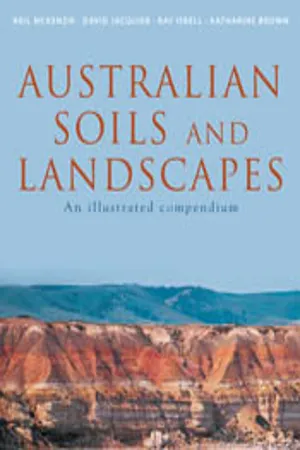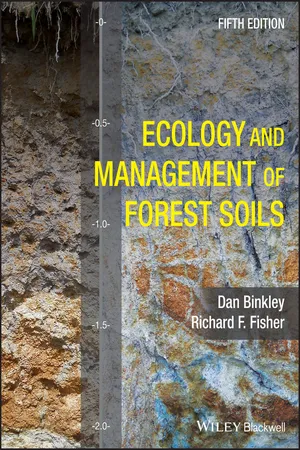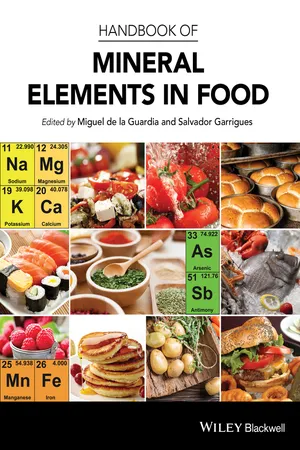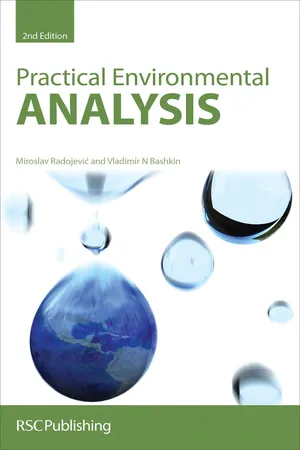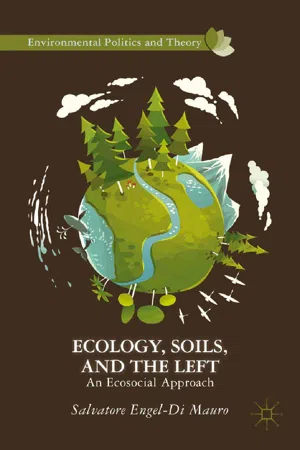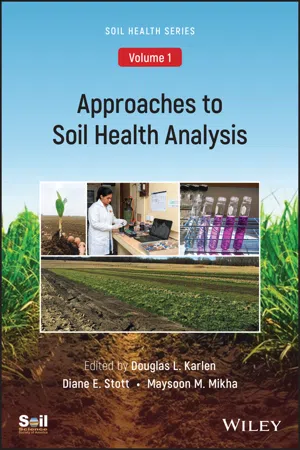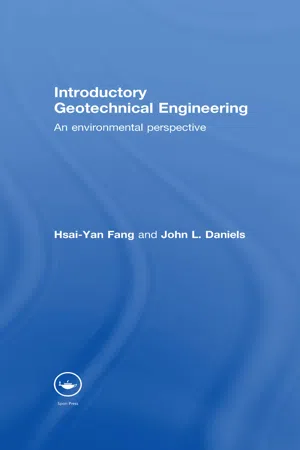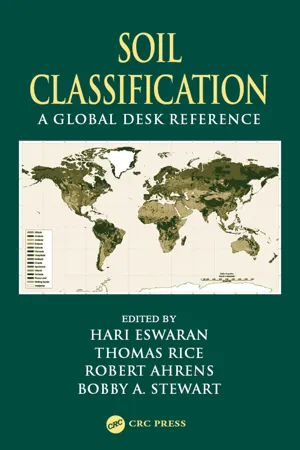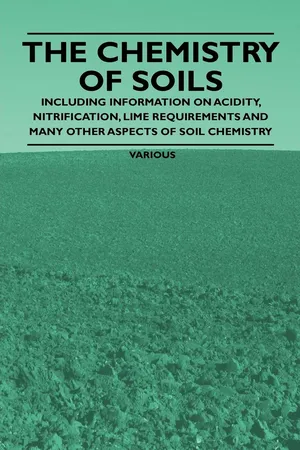Geography
Soil Analysis
Soil analysis involves the scientific assessment of soil properties, composition, and quality. It typically includes testing for pH levels, nutrient content, texture, and organic matter. This process is essential for understanding the suitability of soil for agriculture, construction, and environmental conservation.
Written by Perlego with AI-assistance
Related key terms
9 Key excerpts on "Soil Analysis"
- eBook - ePub
Australian Soils and Landscapes
An Illustrated Compendium
- Neil N. McKenzie, David D. Jacquier, Ray R.F. Isbell, Katharine K. Brown(Authors)
- 2004(Publication Date)
- CSIRO PUBLISHING(Publisher)
Table 1.6 gives an indication of the enormous range in surface area and charge associated with different soil constituents. While clay mineralogy is central to soil behaviour, measurement is an involved process. It is usually more efficient to measure functional properties of soils that relate directly to nutrient availability or water-holding properties. Comprehensive clay mineral data are not widely available in Australia, and in the Compendium, general comments on mineral composition are provided at the start of each soil order.Chemical properties
Morphological properties provide a useful starting point for understanding soil formation, fertility and associated land management, but in many instances more diagnostic physical and chemical measurements are required. Many types of chemical measurement are possible and most aim to characterise the properties outlined in the following sections (Table 1.7 ).Soil solution
Water in soil occurs as a soil solution that carries varying quantities of ions. The soil solution contains nutrients necessary for plant growth, products of weathering, and other soluble salts. At any instant, the soil solution only contains a small fraction of the total nutrient content of a soil (approximately 1% or less). By itself it is insufficient to produce a crop,7 but as plants withdraw nutrients from the soil solution additional ions are released from exchange sites (see below) or from the breakdown of organic matter. Chemical properties measure the state of this nutrient supply system along with various other aspects of the soil solution. One of the most important characteristics of the soil solution is whether it is acid, neutral or alkaline and this is measured by pH.pH
The term pH is a measure of the activity of the hydrogen ion (H+ ) – its effective concentration in the soil solution. The range of pH values found in soil is shown in Figure 1.8 . Importantly, pH exerts strong control on the soil chemical environment. In large measure, it determines the nature of weathering and the availability of nutrients to plants (Figure 1.9 - eBook - ePub
- Dan Binkley, Richard F. Fisher(Authors)
- 2019(Publication Date)
- Wiley-Blackwell(Publisher)
Soon, computer‐based applications were developed, and the McHarg technique became very popular in landscape architecture. Geologists and natural resource managers discovered the technique and geographic information systems were born. Several commercial systems and systems in the public domain are now available. These allow users to store geographically mapped information and tabular information in “layers” and then combine that information to make interpretations (Burrough and McDonnell 1998 ; Bestelmeyer et al. 2008 ; Krasilnikov et al. 2008). GIS are now used by many natural resource managers to make informed management decisions. The mapping of information such as soil type, slope, drainage class, vegetation type, stand type, parent material, etc. into a GIS is fairly straightforward. But what if we would like to map soil properties such as organic matter content, soil acidity, etc., which require us to sample the landscape and analyze the samples? Much of our soil information is in the form of an observation that relates to a particular location in space and time. Knowledge of an attribute value, say organic matter content or soil acidity, is thus of little interest unless location or time of measurement, or both, are known and accounted for in any analysis. Geostatistics provide a set of statistical tools for incorporating spatial and temporal coordinates of observations in data processing. GEOSTATISTICS CHARACTERIZE SOIL PATTERNS Geostatistics are a group of tools for studying and predicting the spatial structure of georeferenced variables. The use of geostatistical tools in soil science is diverse and extensive. They have been used for studying and predicting soil contamination in industrial areas, for building soil quality maps at the field level, and even to map physical and chemical soil properties at the landscape level (Goovaerts 1997) - eBook - ePub
- Miguel de la Guardia, Salvador Garrigues(Authors)
- 2015(Publication Date)
- Wiley-Blackwell(Publisher)
Similarities in parent material, vegetation and climate would indicate that soil samples collected in close proximity are more similar in their soil properties and processes than soil samples separated by long distances [13]. These authors investigated how the variability of some soil properties (such as C and N concentration, particulate organic matter, and other parameters) increases from small (1 m) to large (1 km) scale within the same ecosystem (mixed hardwood forest in the USA). The results obtained show that increasing variability with increasing spatial scale was not valid for five of the eleven factors studied [13].At present, the quality of soil resources is increasingly important for the sustainable productive capacity of an agrosystem, making soil a strategic developmental resource in many countries, especially countries where soil productivity is now declining as the demand for food grows [17].Worldwide compatible soil databases (which include information harmonized in time and space) are crucial for establishing the current status of soils and guiding the shift of technologies from one area to another with similar characteristics and climate [18]. Institutions in a number of countries have made efforts to establish soil maps. The primary information source is a soil survey in which soil properties are collected and made available for land use decision-making purposes [19]. Recently, soil maps have been employed to provide chemical and physical data inputs within ecological and hydrological process models [20], which has been possible due to technological advances such as remote sensing and geographical information systems [19].Predictive soil mapping, based on numerical and/or statistical models, relates environmental variables and soil properties coupled to geographic databases and is very important in establishing the relationship between these parameters to collect the best soil data, to produce and present the soil landscape, and to incorporate expert knowledge in model design [19]. The review paper published by Scull et al - eBook - ePub
- Miroslav Radojevic, Vladimir N Bashkin(Authors)
- 2015(Publication Date)
- Royal Society of Chemistry(Publisher)
CHAPTER 5
Soil, Sediment, Sludge, and Dust Analysis
5.1 INTRODUCTION
The experiments outlined in this chapter can be used to analyse solid samples such as soils, sediments, sludges, and dusts. The experimental procedures for these samples are all quite similar and they involve the extraction of the analyte species and their conversion into a form suitable for chemical analysis. This is in contrast to water samples, which, in many cases, can be analysed directly, or with minimum treatment. Greater emphasis is placed on Soil Analysis than on the other solid samples due to the important role soils play in biogeochemical cycling of nutrients and pollutants, and their vital role as the medium on which food is grown. The subject material of this chapter is closely linked with that of Chapter 6 , which deals with plant analysis.5.1.1 The Pedosphere
Pedos means soil in Greek and the term pedosphere is used to denote the soil cover of the terrestrial part of the earth. Pedology is the science of soils, and the methods of studying and analysing soils and soil processes are an integral part of it. Soil is the main component of the biosphere, which is the vital layer of our planet populated by various organisms, from tiny bacteria to plants, animals, and humans, and it provides a central link between different biospheric compartments. Soils are the most characteristic feature of the terrestrial environment providing a means of physical support for all terrestrial organisms, plants, and animals. They also supply nutrients required by living organisms. Since plants grow on soil, and animals graze on it, nutrients and toxic pollutants in the soil may be transported through the food chain.Soils have numerous uses but the most vital is their use for growing crops, without which no human or animal could survive. Earliest human civilisations sprung up when man learned how to cultivate the soil and, to this day, agriculture remains the most important of all human activities, since without it neither our society nor our race, would be able to exist. Even today, more than 50% of the world population lives on farms. - eBook - ePub
Ecology, Soils, and the Left
An Ecosocial Approach
- Kenneth A. Loparo(Author)
- 2014(Publication Date)
- Palgrave Macmillan(Publisher)
Chapter 2 , soil knowledge systems are context-specific, but they overlap because soils also exist independently of society. Associations of interacting organic and mineral materials, organisms, air, and water (i.e., soils) occur independently of how we explain them. Explananda are anyway not reducible to their explanantia. The biophysical sciences cross social contexts, even as they are socially constructed. Besides there being no single version of science, the biophysical sciences should not be conflated with Western European ideological predominance since they are the historical product of the workings of different interacting social systems and people– environment relations. In this work, mainstream scientific views about the environment, including soils, are used and placed under scrutiny because they form the basis for global comparisons and the backbone of soil knowledge generally, even among the most ardent critics of “Western” science, who do not jettison, for example, studies on soil erosion or climate change on account of the studies’ social provenance (see also Blaikie 1999). With such understandings of science, soils can be defined as both land and, to a limited extent, subaqueous phenomena comprised of bound mineral and organic materials, together with living organisms, water, and air. They are weathered mineral and/or organic material organized in layers (horizons) and characterized by the binding of mineral and organic substances, possibly at molecular scale (the clay-humus complex). Soils form by the addition, loss, movement, and transformation of materials. Over time, soils are created with the pivotal involvement of organisms, including people, alongside other major influences, namely climate, topography, parent material, and relatively low frequency high-impacting phenomena (earthquakes, volcanic eruptions, meteorite bombardment, and the like). Interactions among and change within these factors produce soil diversity (Phillips 2001b).What follows is an overview of major soil properties (biological, physical, and chemical) because they form the basis for evaluating the state of a soil (soil quality) and hence whether a soil is deemed to be degraded (a topic taken up in Chapter 4 - Douglas L. Karlen, Diane E. Stott, Maysoon M. Mikha(Authors)
- 2021(Publication Date)
- ACSESS(Publisher)
2003 ). Furthermore, several visual, in‐field, and laboratory methods for evaluating soil health have been developed over several decades. Answers to those questions are not simple because the living and dynamic nature of soils results in fiscal, human resource, intellectual, and other research constraints associated with sampling, analyzing, and interpreting how soil biological, chemical, and physical properties and processes affect soil health. Our objectives for this chapter are to provide practical definitions and examples of various approaches for addressing soil health, along with our assessment of current analytical methods, their limitations, and potential research topics that may clarify and help advance the concept.Definitions
Within the context of soil health, we suggest the term “benefit” refers to a human defined and desired change in soil physical, chemical, and/or biological properties and processes because of their effect on critical functions (i.e., productivity, filtering and buffering, water entry, retention and release) that soils provide for humankind. For example, a decrease in soil compaction, and an associated increase in soil porosity, would be considered a physical soil health benefit because less compacted soils allow more water to infiltrate and be stored in the soil. Those water and retention benefits subsequently improve productivity as plants are able to extract and use the soil water, and provide environmental benefits because the rate and amount of water running off the site (carrying soil particles, nutrients, pesticides, etc.) is decreased. Soil pH can be used to illustrate the role of chemical properties and processes in a soil health assessment because it affects critical soil functions such as nutrient availability and fitness for plant root growth and development. With regard to soil biological properties and processes, soil organic matter (SOM) or a closely associated measurement (i.e., active carbon, β‐glucosidase, particulate organic matter) can be monitored over time to determine how various soil and crop management practices are affecting the soil (Gebhart et al., 1994 ; Li et al., 2017- eBook - ePub
Introductory Geotechnical Engineering
An Environmental Perspective
- Hsai-Yang Fang, John L. Daniels(Authors)
- 2017(Publication Date)
- CRC Press(Publisher)
Figure 2.5 , the soil is a silt loam.2.7 Chemical composition of natural soils
Considering the great variability of the chemical composition of the parent materials from which soils are formed, an equally great variability in soil composition may be expected. The most general chemical soil classification was made by Marbut (1920) by dividing soils into two classes, namely- Pedalfers : Soils of humid climates (precipitation > evaporation), therefore, water percolation and elutriation resulting in a relative concentration of iron (Fe) and aluminum (Al) compounds in one of the profile/horizons; and
- Pedocals : Soils of semiarid and arid climates (precipitation < evaporation) resulting in salts such as calcium carbonate (CaCO3 ) concentration within or on the surface of the soil profile.
2.7.1 General chemistry of soil
Soil is composed of a variety of chemical compounds. Considering soil as part of the earth’s crust, over 98% of the material is composed of the elements oxygen, silicon, aluminum, iron, calcium, sodium, potassium, and magnesium. Combinations of silicon and oxygen in the form of silicates represents the majority of soil minerals.2.7.2 Soil organic matter
Soil organic matter is a mixture of many different compounds, the more important of which are carbohydrates, proteins, fats, and resins. The absolute amounts and relative proportions of these compounds vary with the climate and macro- and microbiologic activities in the soil. The organic matter is concentrated in the surface layers and decreases with increasing depth in the soil. It ranges from less than 1% in inorganic solids and sands to almost 100% of the solid matter in peat bogs. Further discussion is presented in Section 2.11 .2.8 Characteristics of granular soils
Granular soils in cold and temperate-humid climates contain predominantly quartz and mixed silicates of various tri-, di-, and monovalent metals. In hot-humid climates, they may contain mechanically strong and water resistant secondary aggregations of hydrogen ions (H+ ) and aluminum oxides (Al2 O3 - eBook - ePub
Soil Classification
A Global Desk Reference
- Hari Eswaran, Robert Ahrens, Thomas J. Rice, B.A. Stewart(Authors)
- 2002(Publication Date)
- CRC Press(Publisher)
2. Genesis is less of a mixed bag, as genetic relationships can be separated into facets that emphasize special factors, features, or concepts. Particular attention can be given to what, where, and why parent materials are the initial stage of evolution. Deciphering pathways of processes that seem to result in specific kinds of soils may be a main purpose. Development of morphology has always been important, and so the static-historical properties are given more emphasis. Geographic distributions of kinds of soils as a consequence of evolution and pedogenetic development are valued purposes as well.Table 4.3 Defining Characteristics of the Categories in Soil TaxonomyCategory Definition Functions Potential Uses Order Soils having properties (marks) or conditions resulting from major soil-forming processes that are sufficiently stable in a pedologic sense, and that help to delineate broad zonal groups of soils. Depict zones where similar soil conditions have occurred for general understanding of global patterns of soil resources Establish global geographic areas within which more specific factors and processes result in the diversity of soils General global/continental/regional assessment global climate change studies AMS: < 1:10,000,000 MSD: > 40,000 Suborder Soils within an order having additional properties or conditions that are major controls, or reflect such controls on the current set of soil-forming processes, and delineate broad ecosystem regions. Demarcate broad areas where dominant soil moisture conditions generally result from global atmospheric conditions Delineate contiguous areas with similar natural resource endowments Ecosystems with distinct vegetation affinities usually determined by limiting factor/s of soil moisture or conditions Demarcate areas in regions or large countries for assessment and implementation of economic development Analysis of international production and trade patterns Priority setting for multipurpose uses of land resources - Various Authors(Author)
- 0(Publication Date)
- Read Books Ltd.(Publisher)
SOILS
IN the early days of agricultural chemistry, it appeared reasonable to hope that the simple chemical analysis of soils would unmistakably reveal specific causes of infertility and lead to the growth of larger crops. Although this aim is at present without complete realisation, the intervening years have been fruitful by bringing a broader outlook and a much fuller appreciation of the complexity of soil problems, and in particular of those problems which involve the relationship between soil and plant. Much of a practical nature has, however, been accomplished, for the causes of infertility in large numbers of soils are clearly revealed by laboratory tests. Further progress will follow the correlation of laboratory work with the results of reliable field trials.The academic worker may be profoundly interested in soil as such, and regardless of its crop potentialities, and the farmer may be solely interested in his soil from the point of view of its crop-producing power, but between the two is the farmer’s scientific adviser, whose soil studies are made with an immediate utilitarian object. There is, moreover, an educational aspect of such soil studies, for in few subjects is it so difficult to obtain the essential view from behind the scenes, to enable the tangled skein of factors which make up soil fertility to be unravelled.The exercises described in this section illustrate the methods by which the agricultural properties of soils are studied in the laboratory, with sufficient annotation to enable the student to appreciate the educational value of the work.It is, however, important that knowledge gained in the laboratory should be supplemented by observations on soil structure, variation in texture, reaction, etc. made in the field under the guidance of an experienced person—a form of instruction which written notes can hardly replace and which is impossible to give within the confines of size and scope of this book. Consequently the value of the laboratory work is greatly enhanced if conducted upon soil samples taken during the course of field study.
Learn about this page
Index pages curate the most relevant extracts from our library of academic textbooks. They’ve been created using an in-house natural language model (NLM), each adding context and meaning to key research topics.
